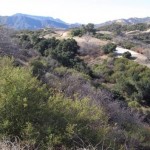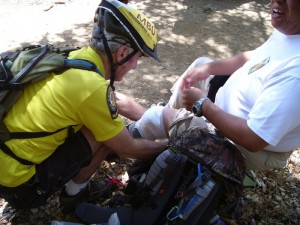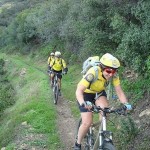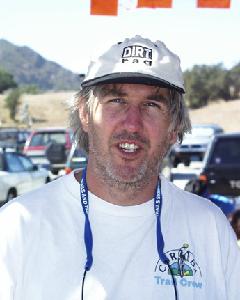 Most trails in our local riding area don’t respond well to rain. They have a high content of clay that turns into sticky, slippery muck that binds to everything it touches. It builds up on the tires, like a snowball rolling downhill, until it jams on the frame and the wheels won’t budge. Some models of clipless pedals refuse to yield when full of this mud, resulting in the bike and the attached rider lying sideways in a puddle.
Most trails in our local riding area don’t respond well to rain. They have a high content of clay that turns into sticky, slippery muck that binds to everything it touches. It builds up on the tires, like a snowball rolling downhill, until it jams on the frame and the wheels won’t budge. Some models of clipless pedals refuse to yield when full of this mud, resulting in the bike and the attached rider lying sideways in a puddle.
Most wet trails don’t respond well to bikers, hikers or equestrians until they’ve had time to dry out. Hikers and horses make holes and ridges in the trail that become as hard as concrete when the trail dries. These holes and ridges are good for twisting ankles of trail users who aren’t constantly watching their step.
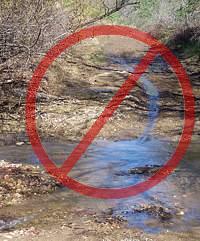 On wet trails, bikes make grooves down the middle. These grooves collect water when it rains again, turning first into little channels to move the water downhill, then into little ruts, then large ruts that destroy the trail. You’ve heard about the beat of a butterfly wing that causes a hurricane? Then remember the tire track that turns a tail into one large rut!
On wet trails, bikes make grooves down the middle. These grooves collect water when it rains again, turning first into little channels to move the water downhill, then into little ruts, then large ruts that destroy the trail. You’ve heard about the beat of a butterfly wing that causes a hurricane? Then remember the tire track that turns a tail into one large rut!
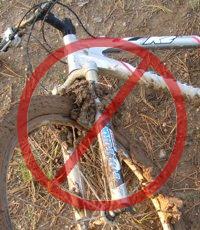 And the mud is particularly hard to remove. It sticks to the bike and shoes, no matter the efforts to remove it, rubbing off on the bike rack, car carpet and floor pedals. Once home, it takes the careful use of a garden hose to remove the mud but not force water into the sensitive parts of the bike.
And the mud is particularly hard to remove. It sticks to the bike and shoes, no matter the efforts to remove it, rubbing off on the bike rack, car carpet and floor pedals. Once home, it takes the careful use of a garden hose to remove the mud but not force water into the sensitive parts of the bike.
For these reasons, riders are well advised to stay off the trails after a rain until they have dried. How long to stay off? That depends on a number of factors including the particular trail, how much rain it received, how much sun it gets after the rain (is it in the shade or face south?), how warm and windy the weather is, and so on. After an isolated light rain you can probably ride the next day. After a heavy rain, you should wait several days. This is something where common sense and experience will help.
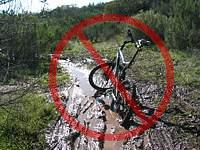 But if the trails are soaking, all is not lost if you need to ride! There are a few trails that hold up well when wet because they have more sand and rock that doesn’t hold the water. Here are a few you should know about:
But if the trails are soaking, all is not lost if you need to ride! There are a few trails that hold up well when wet because they have more sand and rock that doesn’t hold the water. Here are a few you should know about:
–Space Mountain (Los Robles West) to the picnic table is almost always rideable, even right after a big storm. However, it can be pretty mucky from the picnic table to Potrero Road.
–Rosewood Trail is pretty good, but not quite as resiliant as Space Mountain.
–Zuma Ridge Motorway from Encinal (the bottom in Malibu is muddy)
–Dirt Mulholland around Topanga State Park.
-Brown Mountain Fireroad
-Most San Gabriel Mountains trails made up of decomposed granite
-Beaudry Fireroad
-Hostetter Fireroad
-Mt. Lukens


